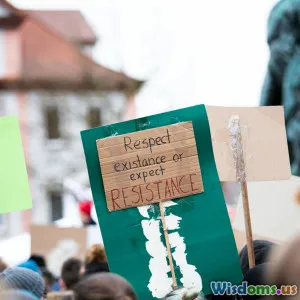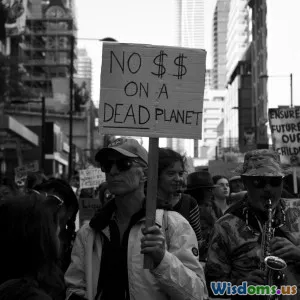
The Role of Dadaism in Political Protest
7 min read Explore how Dadaism, a radical art movement, became a potent tool of political protest challenging war and authoritarianism. (0 Reviews)
The Role of Dadaism in Political Protest
Dadaism stands out as one of the most provocative and unconventional art movements in history. Born amidst the devastation of World War I, it radically rejected the order, rationality, and nationalistic fervor that had led to unspeakable suffering. But Dadaism was not simply an artistic rebellion — it was deeply political. Through chaotic imagery, nonsensical poetry, and experimental performances, Dadaism became a rallying force against war, authoritarianism, and established cultural norms. This article explores the origins of this radical movement, its direct connection to political protest, and its lasting legacy in contemporary activism.
Origin and Context: The Birth of Dada Amidst Chaos
Dadaism was founded in 1916 at the Cabaret Voltaire in Zurich by a group of artists and intellectuals who were disillusioned by the senseless carnage of World War I. Figures like Hugo Ball, Tristan Tzara, and Jean Arp sought to challenge the very foundations of the society that had led to such brutal conflict. More than an art style, Dada was a mode of political expression—a profound critique of a world ruled by nationalism, militarism, and bourgeois complacency.
By deliberately embracing absurdity, irrationality, and anti-art aesthetics, Dadaists questioned the values that dictated culture and politics. The movement soon spread across Europe and America, inspiring provocative events, publications, and artworks that undermined war propaganda and authoritarian rhetoric.
The Political Power of Absurdity and Nonsense
One of Dadaism's most potent tools was its absurdity. In a period when propaganda demanded seriousness and conformity, Dada artists unleashed chaotic performances and nonsensical poetry to mock established political messages. For example, Tristan Tzara’s poetry readings were deliberately incomprehensible, stripping language of its conventional meaning to expose the hollow ideologies of the time.
This subversion destabilized the authority of language—the primary weapon of governments and institutions. By refusing to communicate in traditional ways, Dadaists disrupted the usual channels through which political power was upheld. Their art was thus a form of direct political resistance that called into question the legitimacy of governing systems that had plunged humanity into conflict.
Dadaist Iconoclasm: Destroying Artistic and Political Conventions
Dadaism extended its rebellion beyond words into objects and visual arts. Marcel Duchamp’s "Fountain" (1917), a porcelain urinal signed with a pseudonym, is among the most profound examples of political protest through art. This "readymade" challenged the notion of artistic value—and by extension social and political values—remarking on how arbitrary accepted norms are.
By disrupting traditional aesthetics, Dada artists attacked the cultural institutions that underpinned political oppression. The movement’s iconoclastic spirit mirrored and prefigured anti-establishment political protests. This blend of aesthetic shock and political rebellion conveyed a powerful message: existing structures were meaningless and deserving of dismantling.
Dadaism’s Direct Antimilitarism and Anti-Fascism
Dada explicitly opposed militarism and rising fascist ideologies that characterized the interwar period. Dadaist actions often included provocative street performances and manifestos denouncing nationalism and warfare. For instance, in Berlin, the political tension and social unrest fueled expressions like Hannah Höch’s photomontages, which critiqued militarism and gender norms, highlighting the dangers of rising authoritarianism.
In this way, the movement influenced subsequent anti-fascist and pacifist activism. Its embrace of chaos was not nihilistic but intentionally aimed at exposing the vulnerabilities of totalitarian regimes and the disastrous consequences of war.
Legacy and Influence on Modern Political Protest
While Dadaism formally waned in the 1920s, its spirit of radical dissent permeated future political and cultural movements. The Situationist International in the 1950s and '60s, punk subcultures, and even contemporary activist art owe a debt to Dada’s irreverence and critique of power through play and disruption.
Street art, flash mobs, and satirical performances today echo Dadaist techniques of using humor, shock, and defamiliarization to undermine political propaganda and galvanize public awareness.
For example, the art collective The Yes Men comically impersonates corporations and government agencies to reveal hidden truths—an approach very much rooted in Dadaist absurdity and confrontation.
Conclusion: Dadaism as a Template for Artistic Political Activism
Dadaism’s impact transcends art history; it offers a blueprint for political protest that uses cultural disruption and satire to challenge oppressive systems. As political tensions rise globally today, revisiting Dada's strategies illuminates the enduring power of creative rebellion.
This movement teaches us that by distorting the familiar, mocking authority, and embracing the absurd, art can be a formidable weapon in confronting injustice.
Ultimately, Dadaism reminds activists and artists alike that resistance does not always come from solemn declarations but often from the unexpected humor and chaos that dismantle the foundations of power.
Rate the Post
User Reviews
Popular Posts





















